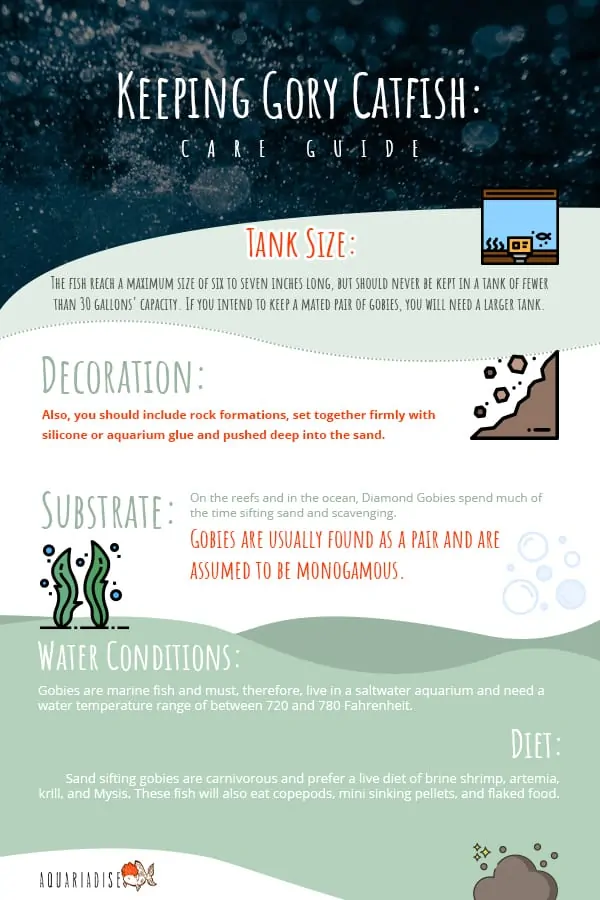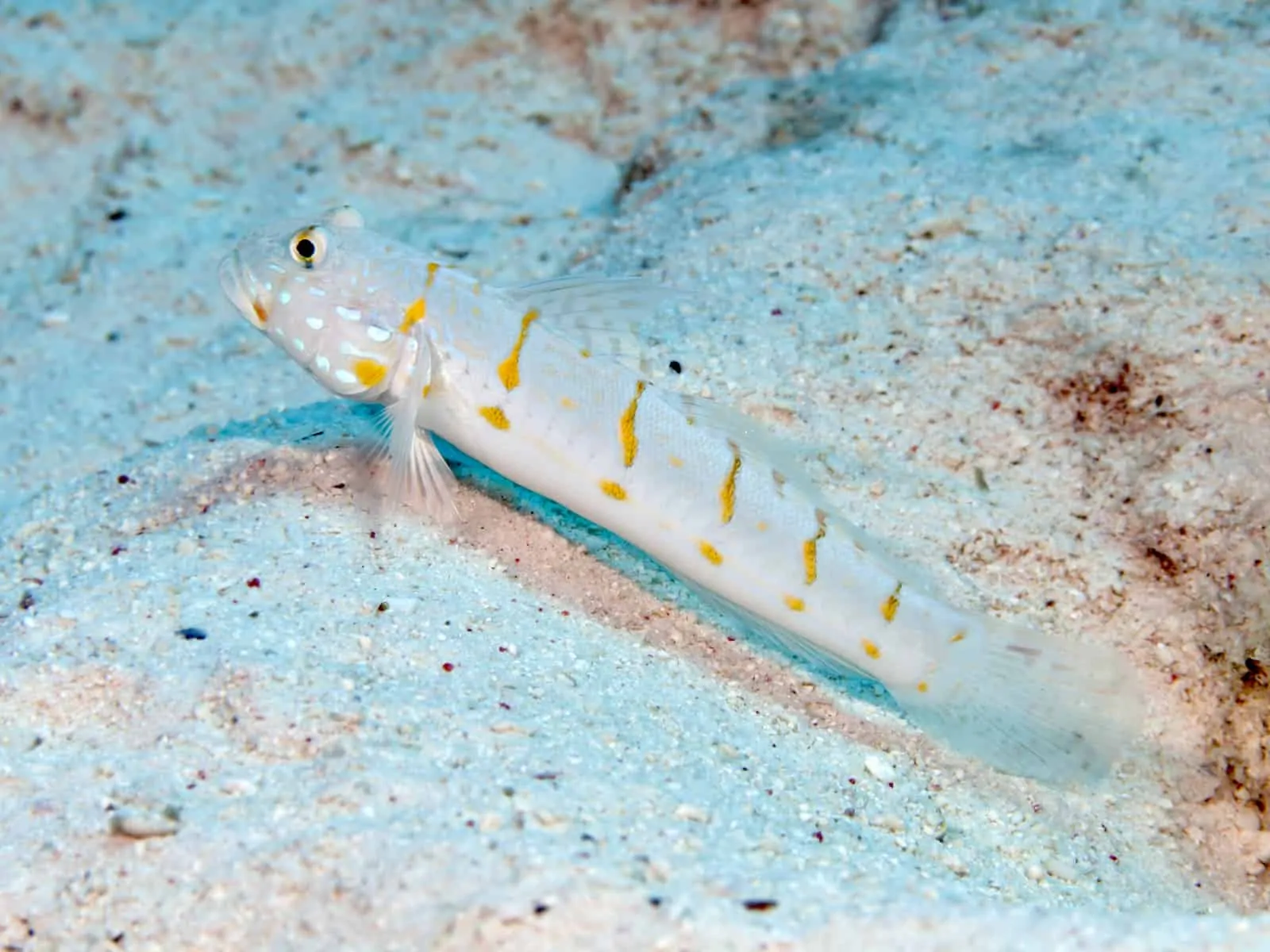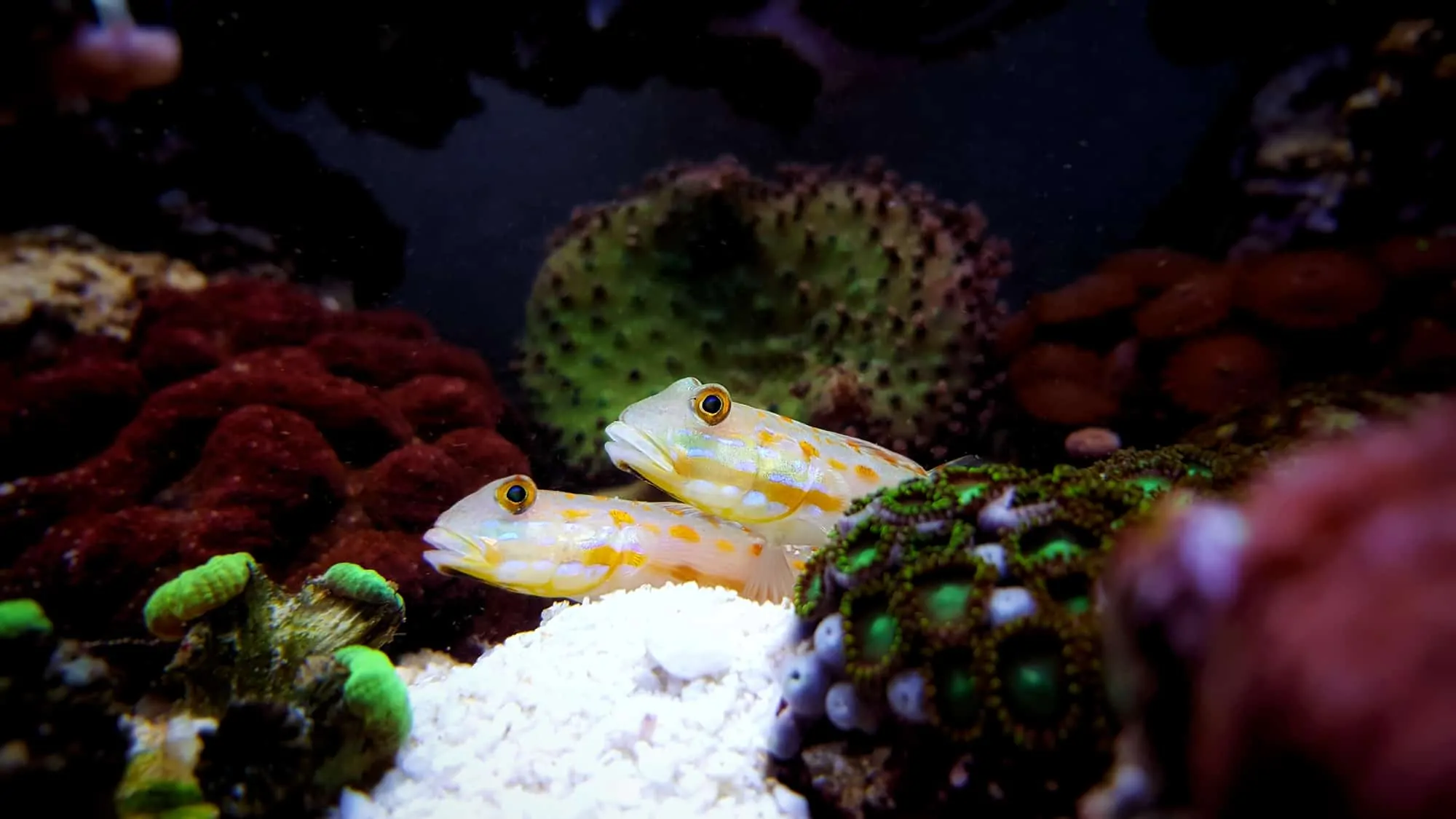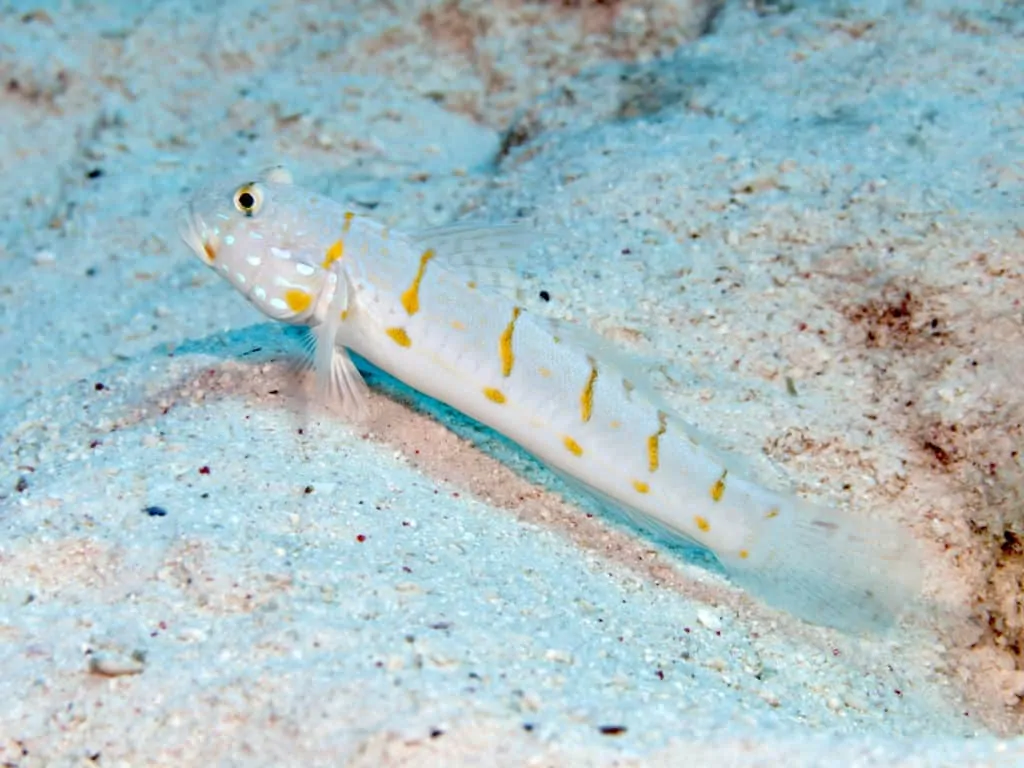If you have a saltwater aquarium and you’re looking for a characterful and interesting little fish to add to your collection, the Diamond Goby could be just what you need.
In our guide to the Diamond Goby, you’ll learn how to care for one of these cute fish, as well as how to breed them.

Introducing the Diamond Goby
The Diamond Goby has many names, including:
- Pretty Prawn
- Diamond Watchman Goby
- Maiden Goby
- Orange spotted Diamond Goby
- Orang spotted Sleeper Goby
- Orange Dashed Goby
The fish’s scientific name is Valenciennea puellaris.
Origins and Habitat
The Diamond Watchman Goby waw first discovered in 1956 in the Indo-Pacific Ocean by the Japanese naturalist, Tomiyama.
Today, these beautiful fish are found in large numbers in several different parts of the world, including the West Indian Ocean, East Indian Ocean, Australia, Fiji, Sri Lanka, Vanuatu, and Indonesia where they inhabit the sand bed.
Diamond Watchman Goby Appearance
Watchman Gobies grow to around eight inches in their natural environment. In an aquarium, these fish typically reach six to seven inches.
The Goby’s head is somewhat large compared to the rest of its body, and the jaws are usually cyan in color. Diamond Gobies are eye-catching marine fish dotted with tiny brilliant orange diamond shapes across a fluorescent white body. Their bulbous, protruding eyes give the fish a comical look, especially when seeking peeking out from the depths of a sand burrow.
The Pretty Prawn is one of the most beautiful goby species that surely deserves a special place in the home aquarium.
Care of the Diamond Goby
Diamond Gobies are not demanding fish and have a care level that’s regarded as easy, making them the ideal choice for a beginner hobbyist. Also, these are hardy fish that are disease-resistant.
Tank Size
The fish reach a maximum size of six to seven inches long, but should never be kept in a tank of fewer than 30 gallons’ capacity. If you intend to keep a mated pair of gobies, you will need a larger tank.
Gobies are renowned for jumping, so your tank must have a tight-fitted lid.
The species is happiest in an aquarium that is long rather than tall.
Tank Decoration and Substrate
On the reefs and in the ocean, Diamond Gobies spend much of the time sifting sand and scavenging. Gobies are usually found as a pair and are assumed to be monogamous. Often, these sand sifting gobies create a burrow in the sand bed where they will rest or hide when alarmed, so you must provide them with at least three to four inches depth of soft sand as a substrate so that they can create a place within the sand where they feel safe and secure.
Also, you should include rock formations, set together firmly with silicone or aquarium glue and pushed deep into the sand. That’s important, as the Diamond Goby may dislodge the rocks while digging, potentially injuring themselves and other tankmates.
Water Conditions
Gobies are marine fish and must, therefore, live in a saltwater aquarium.
Gobies need a water temperature range of between 720 and 780 Fahrenheit. A pH level of between 8.1 and 8.5 is ideal, with a dKH of between 8 and 12 and water-specific gravity of 1.020 to 1.025.
Water cleanliness should be maintained, and your filter system should generate a fairly strong current to replicate conditions in the gobies’ natural habitat. Also, a partial water change of 25% is required at least every two weeks. To help maintain optimal saltwater quality in your reef aquarium and to keep nitrate levels down, you should use RO-DI water, which you can buy from a good aquarium store or create yourself using an RO-Di unit to filter your tap water.

Diet
Sand sifting gobies are carnivorous and prefer a live diet of brine shrimp, artemia, krill, and Mysis. These fish will also eat copepods, mini sinking pellets, and flaked food. A combination of these foods will help to keep your Diamond Goby specimens healthy and thriving.
Watching these active little creatures feeding is fascinating. Live food, such as shrimp, will disappear into the substrate, and the gobies then spend much of their day sifting through the sand bed, hunting down escapees of which to make a meal. The fish scoop up mouthfuls of sand, which they filter through their gills, extracting tiny morsels of food, such as invertebrates, as they do so.
Be careful not to overfeed your fish, as that can lead to health problems. It doesn’t matter what time of day you feed, but make it a routine to feed your pets small portions twice or three times each day.
Valenciennea puellaris are bottom feeders, so if you have other species in your aquarium, you’ll need to make sure that all your fish get an adequate share of the food you offer them. Observe the community carefully to make sure that enough food is available at the bottom for the Pretty Prawns. One way of ensuring that bottom dwellers get their fair share is to use a turkey baster to deliver live or defrosted frozen foods close to the entrance to the fishes’ burrow.
Tankmates
If you want to add interest and color to a reef home aquarium, it’s important to use a mixture of different species. However, it’s vital that all members of the community get along well.
The sand sifting goby is a peaceful fish and can be kept with other reef-safe fish that are not aggressive. Species that make safe tankmates for your Diamon Goby include:
- Damsels
- Clownfish
- Shrimps
- Dwarf Angelfish
- Filefish
- Pink Fairy Wrasse
- Foxface Rabbitfish
- Cleaner Wrasse
However, Valenciennea puellaris can be aggressive and territorial when placed in close proximity to other burrowing gobies, and for that reason, we recommend that you keep just one individual or a mated pair of the same species.
One tankmate that’s almost certain to get along well with the Diamond Goby is shrimp. Shrimp make an interesting, lively addition to your marine tank and can be helpful in that they may eat leftover food that drifts down onto the sand bed from above. That said, these invertebrates won’t compete with your Diamond Goby for food.
Breeding Valenciennea puellaris
Although it is possible to breed sand sifting gobies, you do need to pair them correctly, and that’s the tricky part!
The Diamond Watchman Goby is what’s called a protogynous fish. That means that the fish can change gender whenever it needs to. In the wild, that ability means that the fish will always be able to breed without having to find another goby of a specific sex, which can be a handy ability to have in sparsely populated areas.
In a tank situation, it’s best to ask an expert in your local aquarium store to determine the sex of the fish you’re buying if possible. That said, both the sexes do look pretty much identical, so differentiating between them can be extremely difficult.
When it comes to spawning, the male and female spotted goby place their fertilized eggs on top of their sand burrows. The male guards the eggs for a few days while waiting for them to hatch. Once the fry emerges, you’ll need to provide them with plenty of food and a diet of live plankton is essential. Plankton is not easy to obtain, and you may need to order a supply of the items that you need from a saltwater aquarium specialist supply store. Alternatively, an email to a .com online supplier could get you the foods you need for your baby Pretty Prawns.
A diet of plankton should enable the fry to survive and grow. However, you may need to remove them from your main tank and replace them in a separate nursery tank to prevent them from being eaten by other fish.

FAQ
In the next part of our guide, we address some of the most commonly asked questions about feeding and caring for the Pretty Prawn.
Q: What does a Diamond Goby eat?
A: The Diamond Goby is exclusively a diet carnivore. Ideally, you should feed your fish live foods, including artemia, Mysis, krill, brine shrimp, and copepods. The fish may also eat flaked food, mini sinking pellets. You may also like to offer frozen food that should be defrosted in tank water before being introduced to the sand bed of the tank via a turkey baster or similar utensil.
Q: How big do Diamond Gobies get?
A: In the home tank, Diamond Goby specimens can grow up to six or seven inches in size.
Q: Are Diamond Gobies reef safe?
A: Yes. The Orange Spotted Goby is a peaceful fish that may be kept with other reef-safe fish. That said, these fish can be territorial over their sand burrows, so it is best to keep one individual or a mated pair.
Q: Do Diamond gobies eat copepods?
A: Yes. The Pretty Prawn, as this attractive fish is also known, does eat copepods, as well as other live foods.
Final Thoughts
The Diamond Goby comes under the category of “care level easy,” making this attractive, interesting creature a wonderful addition to a large marine or reef tank. Also, these fish are readily available from most marine fish stores, meaning that they are not too expensive for the novice hobbyist to buy.
Gobies live in burrows and spend much of their time sifting through the sand bed in search of scraps and items of live food, including copepods, brine shrimp, and the like. These fish have a special ability to change their gender as required and will readily spawn, given the right conditions and diet.
Adding a pair these Pretty Prawns to your tank is sure to please both you and visitors who will be enchanted by these beautiful fish as they peep out from their sand bed burrows, regarding onlookers with their large, protruding eyes and permanently puzzled expression.


